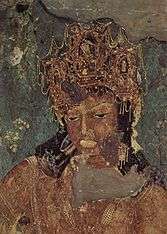Harishena
| Harishena | |
|---|---|
| Reign | c. 475 – c. 500 CE |
| Predecessor | Devasena |
| House | Vakataka dynasty |
| Vakataka dynasty 250 CE–500 CE | |
 |
 |
| Vindhyashakti | (250–270) |
| Pravarasena I | (270–330) |
| Pravarapura–Nandivardhana branch | |
| Rudrasena I | (330–355) |
| Prithivishena I | (355–380) |
| Rudrasena II | (380–385) |
| Prabhavatigupta (regent) | (385–405) |
| Divakarasena | (385–400) |
| Damodarasena | (400–440) |
| Narendrasena | (440–460) |
| Prithivishena II | (460–480) |
| Vatsagulma branch | |
| Sarvasena | (330–355) |
| Vindhyasena | (355–400) |
| Pravarasena II | (400–415) |
| Unknown | (415–450) |
| Devasena | (450–475) |
| Harishena | (475–500) |
Harishena (r. c. 475 – c. 500 CE) was the successor of his father Devasena. He was a great patron of Buddhist architecture, art and culture. The World Heritage monument Ajanta is surviving example of his works. The rock cut architectural cell-XVI inscription of Ajanta states that he conquered Avanti (Malwa) in the north, Kosala (Chhattisgarh), Kalinga and Andhra in the east, Lata (Central and Southern Gujarat) and Trikuta (Nasik district) in the west and Kuntala (Southern Maharashtra) in the south.[1] Varahadeva, a minister of Harishena and the son of Hastibhoja, excavated the rock-cut vihara of Cave XVI of Ajanta.[2] Three of the Buddhist caves at Ajanta, two viharas - caves XVI and XVII and a chaitya - cave XIX were excavated and decorated with painting and sculptures during the reign of Harishena.[1] According to an art historian, Walter M. Spink, all the rock-cut monuments of Ajanta excluding caves nos. 9,10,12,13 and 15A (Ref: Page No. 4, Ajanta-A Brief History and Guide - Walter M. Spink) were built during Harishena's reign[3] though his view is not universally accepted.
Harishena was succeeded by two rulers whose names are not known. The end of the dynasty is unknown. They were probably defeated by the Kalachuri of Mahismati.[2]
References
- 1 2 Nashik district e-gazetteer - History, ancient period Archived 27 September 2007 at the Wayback Machine.
- 1 2 Mahajan V.D. (1960, reprint 2007) Ancient India, New Delhi: S. Chand, ISBN 81-219-0887-6, pp.590-91
- ↑ Spink, Walter, M. (2009). Ajanta: Defining Features, in Indica, Vol.46, No.1, Mumbai: Heras Institute of Indian History and Culture, pp.3-38